MOVIE REVIEW: HIDDEN FIGURES
March 16, 2017
Written and directed by Theodore Melfi and co-written by Allison Schroeder, Melfi, based on the book by Margot Lee Shetterly, HIDDEN FIGURES is a "must see" film for every American.
This is definitely perfect timing for the release of HIDDEN FIGURES and in fact, should be a double feature with "Jackie", as both take us back to the days of Camelot and the Kennedy administration when America aspired to reach to the moon and the stars beyond, and when a woman showed the world grace and dignity in a time of personal tragedy. Both are defining films for our time and the history of this nation.
Long before computer technology took over the world, number-crunching calculations were done by hand and, in the case of NASA, by human "computers"; groups of women whose sole job was to check the mathematical calculations and trajectories of the all-male teams of engineers who were attempting to put a man in space. Beginning in 1935, women were the "computers" for National Advisory Committee for Aeronautics, the predecessor agency to NASA. After World War II, African-Americans were recruited for the computer teams.
And as comes as no surprise in 1961, there were still "colored computers" and the "white computers". The Space Race was on and the United States was lagging behind the Soviet Union, calling for an "all hands on deck" team effort to win the race. HIDDEN FIGURES is the story of three of the "colored computers" who battled sexism and racism, striking a thunderous chord for equal rights within the male-dominated world of NASA and got us to the moon and beyond - Katherine G. Johnson, Dorothy Vaughan and Mary Jackson.
The fact it has taken this long to tell this story of Katherine, Dorothy and Mary is mind-boggling. The fact that it was NASA being one of the first to desegregate, in keeping with the scientific ideologies that math is the universal language and will be the connective tissue with alien species, is logical and appropriate. Math and science have long been a common thread among countries with different languages. It makes perfect sense that math is what brings down the multiple walls of segregation within NASA.
We first meet our heroines (and yes, they truly are heroines) racing to get to work on time when their Chevy Impala breaks down. Dorothy Vaughan is on the grounds under the car making repairs when a white police officer pulls up behind them, quizzical as to what these women are doing. As the women flash their NASA employee ID's and appeal to the officer's patriotism in beating the Soviets in the space race, his tone changes from that of confrontational to sirens blazing as he serves as a police escort to the trio.
Frustrated with being relegated to a basement holding office, waiting to be given assignments, we start to learn more about each of the women, both on the job and at home. Dorothy is the leader of the "West Computer Group" and fights for her women with the ferocity of a lioness, always thinking ahead, pushing for promotions and pay increases, including one for herself. The latter is a hard fought battle with Vivian Mitchell, a white supervisor, who offers to help Dorothy get a supervisory promotion, not comprehending that Dorothy is already doing the job and just wants to be paid for the work. While somewhat empathetic to the sexism within NASA, Vivian is oblivious to Dorothy's wanting equal pay and the same treatment afforded Vivian and the other "white" employees. Dorothy is also very cognizant of the impending installation of IBM computers which would obviate the need for the "human computers." Determined not to lose her girls, she starts studying Fortran computer programming, subsequently teaching it to her team so that they are ready to step in as programmers once the computers are up and running.
While Dorothy fights on one ground, thanks to her superlative mathematical skills and computational abilities (in her head, mind you) Katherine finds herself promoted to a job within the preeminent Space Task Group. The only woman on the team, and the only African-American, most of the men pay little attention to her presence, but for Paul Stafford. Whiny and always kissing up to the team manager Al Harrison, Stafford realizes how much of a threat Katherine may be - and how much more intelligent she is than he or anyone else in the room - thus doing his best to undermine her effectiveness at every turn. Harrison, hell bent on solving the current trajectory and re-entry issues fails to notice the personnel issues at play, until he is looking for Katherine who it turns out is in the colored restroom across the NASA campus which takes about 20 minutes to reach with a sprint. Harrison strikes a blow for equal rights in a powerful scene in which he rips down the "whites only" bathroom signage, putting an end to yet another form of discrimination and segregation.
Mary Johnson finds herself assigned to an engineering team, which is her heart's desire, but her boss quickly realizes her aptitude for physics and encourages her to apply for a full engineering position. Unfortunately, that requires a specialty degree and the only school that teaches engineering is an all-white school. Undeterred, Mary goes to Court to gain the right to take the necessary night courses. As history tells us, she wins her court battle and earns a post as a NASA engineer.
In a telling scene, a young John Glenn crosses the race barriers by not only meeting the "colored computers" during a tarmac welcome reception, but thereafter puts his full faith and trust in Katherine's mathematical calculations, in fact, refusing to blast off in his first historic flight until Katherine has personally confirmed the trajectory re-entry calculations for him.
While we are engrossed in the women's work at NASA, we also learn of their home lives. Katherine, a widow with young children, eventually finds love again with a man who encourages her talent and ambition. With her mother taking care of the kids by day, money is tight so clothes are handmade, and her home is simple, yet warm and cozy. Dorothy is secure with a husband seemingly successful in business, always maintaining a dignified appearance, holding her head high and never accepting inequality. Mary is hip and trendy with the most light-hearted attitude of the group.
Katherine G. Johnson went on to become a renowned NASA mathematician with her computations influencing every space program from Mercury through the Shuttle, including calculating in 1961 the flight path for Alan Shepard, the first American in space. Viewing the trajectory as a parabola, she worked the geometry backwards. In 1962, Johnson rechecked computer calculations at the personal request of John Glenn before he would go into space. Johnson was awarded the National Medal of Freedom in 2015 and has a building at NASA named for her.
Dorothy Vaughan was also a mathematician at NACA/NASA, and was the first African American woman to be head of personnel at NACA was an American mathematician who worked at the National Advisory Committee for Aeronautics, the predecessor agency to NASA and who, in 1949, was the first African American woman to be head of personnel at NACA. Vaughan retired from NASA in 1971.
After five years at NASA, Mary Jackson was ultimately able to train to become an aerospace engineer. On promotion to full-fledged engineer, she went on to analyze data from wind tunnel and actual flight experiments, focusing on air flow, thrust and drag forces, ultimately assigned to work the flight engineers at NASA. During her time with NACA/NASA, she authored/co-authored 12 technical papers on her work.
HIDDEN FIGURES is their story, an American story, a chapter in history from which we can and must learn.
From visual palette to story structure, HIDDEN FIGURES is exceptionally strong. Characters are well drawn, authentic, and human. There is depth and dimensionality to each, be it Katherine, Dorothy and Mary or Al Harrison, Paul Stafford or Mrs. Vivian Mitchell. Issues of race, but even moreso, gender, mirror the times but aren't an "in your face" lecture. And as we are seeing unfold in the 21st century, as timely now as in 1961.
Performances are rock solid. Layered. Empowering. There is a conviction and strength with intent and purpose to each. Taraji P. Henson is standout as Katherine G. Johnson, immersing herself and the audience in Katherine's frustration at being dismissed by male counter-parts, yet standing firm and confident in her own abilities. Henson also adds a bit of humor in multiple scenes as she runs across the NASA campus to the bathroom in rain, shine, sleet and snow - all in high heels.
Octavia Spencer is a confident warrior. Embracing the essence of Dorothy Vaughan as a leader and go-getter, there is never a moment one does not believe she will go to the mat for her "computers" and do so with dignity. Equally impressive is Janelle Monae, most notably in the courtroom scenes fighting for the right to take the courses to become an engineer.
Jim Parsons personally captures a mousy, yet snippy Paul Stafford, being smug and worrying over losing his job to "a woman". Kirsten Dunst gives one of her most subtle and nuanced performances as Vivian Mitchell. Standout is a bathroom scene between Dunst and Octavia Spencer's Dorothy which encapsulates the mindset of the day as to race and gender, telling of the interesting subtleties within the script - the various forms of discrimination that occur and how the various genders and races interpret and enact it. There is no exclusivity as to who or what discrimination touches in some form, be it intelligence and skill, gender, race, competence.
Kevin Costner's character Al Harrison is an amalgamation of several NASA project managers. Costner fills the bill nicely and as usual, is the embodiment of patriotism and the best of what makes America great.
Director Melfi and cinematographer Mandy Walker have outdone themselves from a cinematographic standpoint. From the lighting and lensing of the distinctly different locations to the integration of archival footage and then compounded by Walker's use of 16mm and 35mm film formats to shoot for period authenticity, there is then a seamless meld with news and NASA footage of the day.
Wynn Thomas' production design excels, notably with the different styles between West Computing and the round design of NASA R&D room. West is small, claustrophobic, darker with a cold dark linoleum floor, used darkwood furniture and cramped desks while R&D has the floor to ceiling window in Al Harrison's office. Significant is the round design as it tacitly harkens to equality among all a la King Arthur and his round table. Home life for each woman is warm and inviting yet shows distinct personality with Mary being the trendiest of the main trio.
Costuming by Renee Kalfus is period perfection and more importantly, perfect for the region - women from the South. The fabrications Kalfus selected for Henson's Katherine are beautiful with great attention to little details that someone making their own clothing would add and designed to make her stand out a bit from the men in math R&D who are all dressed in their black pants, white shirts and black ties. Spencer's Dorothy wears the more basic fabrics designed that are a bit more durable and an upgrade from homemade but not quite Jackie Kennedy fashionable. Janelle Monae's Mary on the other hand is a perfect picture meld of Doris Day and Jackie Kennedy.
It is the subtlety and universality of HIDDEN FIGURES which makes this a cinematic journey that stands apart from the pack; just like Katherine G. Johnson, Dorothy Vaughan and Mary Jackson.
Directed by Theodore Melfi.
Written by Melfi and Allison Schroeder, based on the book by Margot Lee Shetterly
Cast: Taraji P. Henson, Octavia Spencer, Janelle Monae, Kevin Costner, Jim Parsons, Kirsten Dunst

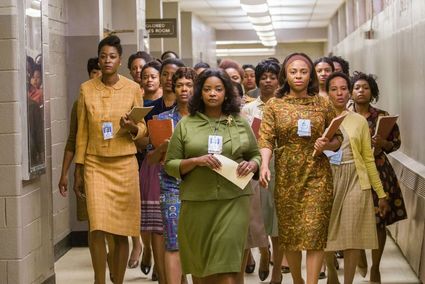
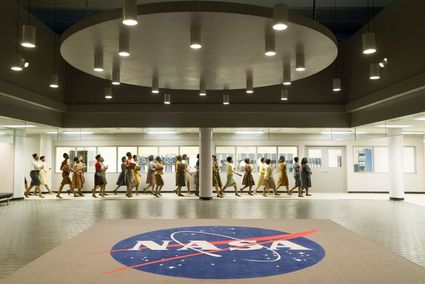
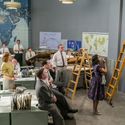
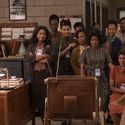
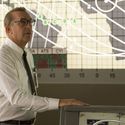
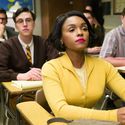

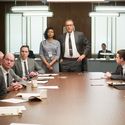
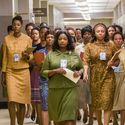



















Reader Comments(0)